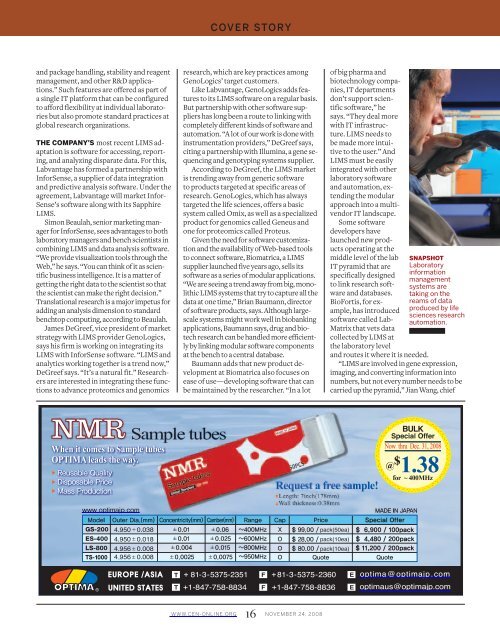Chemical & Engineering News Digital Edition ... - IMM@BUCT
Chemical & Engineering News Digital Edition ... - IMM@BUCT
Chemical & Engineering News Digital Edition ... - IMM@BUCT
Create successful ePaper yourself
Turn your PDF publications into a flip-book with our unique Google optimized e-Paper software.
COVER STORY<br />
and package handling, stability and reagent<br />
management, and other R&D applications.”<br />
Such features are offered as part of<br />
a single IT platform that can be configured<br />
to afford flexibility at individual laboratories<br />
but also promote standard practices at<br />
global research organizations.<br />
THE COMPANY’S most recent LIMS adaptation<br />
is software for accessing, reporting,<br />
and analyzing disparate data. For this,<br />
Labvantage has formed a partnership with<br />
InforSense, a supplier of data integration<br />
and predictive analysis software. Under the<br />
agreement, Labvantage will market Infor-<br />
Sense’s software along with its Sapphire<br />
LIMS.<br />
Simon Beaulah, senior marketing manager<br />
for InforSense, sees advantages to both<br />
laboratory managers and bench scientists in<br />
combining LIMS and data analysis software.<br />
“We provide visualization tools through the<br />
Web,” he says. “You can think of it as scientific<br />
business intelligence. It is a matter of<br />
getting the right data to the scientist so that<br />
the scientist can make the right decision.”<br />
Translational research is a major impetus for<br />
adding an analysis dimension to standard<br />
benchtop computing, according to Beaulah.<br />
James DeGreef, vice president of market<br />
strategy with LIMS provider GenoLogics,<br />
says his firm is working on integrating its<br />
LIMS with InforSense software. “LIMS and<br />
analytics working together is a trend now,”<br />
DeGreef says. “It’s a natural fit.” Researchers<br />
are interested in integrating these functions<br />
to advance proteomics and genomics<br />
research, which are key practices among<br />
GenoLogics’ target customers.<br />
Like Labvantage, GenoLogics adds features<br />
to its LIMS software on a regular basis.<br />
But partnership with other software suppliers<br />
has long been a route to linking with<br />
completely different kinds of software and<br />
automation. “A lot of our work is done with<br />
instrumentation providers,” DeGreef says,<br />
citing a partnership with Illumina, a gene sequencing<br />
and genotyping systems supplier.<br />
According to DeGreef, the LIMS market<br />
is trending away from generic software<br />
to products targeted at specific areas of<br />
research. GenoLogics, which has always<br />
targeted the life sciences, offers a basic<br />
system called Omix, as well as a specialized<br />
product for genomics called Geneus and<br />
one for proteomics called Proteus.<br />
Given the need for software customization<br />
and the availability of Web-based tools<br />
to connect software, Biomatrica, a LIMS<br />
supplier launched five years ago, sells its<br />
software as a series of modular applications.<br />
“We are seeing a trend away from big, monolithic<br />
LIMS systems that try to capture all the<br />
data at one time,” Brian Baumann, director<br />
of software products, says. Although largescale<br />
systems might work well in biobanking<br />
applications, Baumann says, drug and biotech<br />
research can be handled more efficiently<br />
by linking modular software components<br />
at the bench to a central database.<br />
Baumann adds that new product development<br />
at Biomatrica also focuses on<br />
ease of use—developing software that can<br />
be maintained by the researcher. “In a lot<br />
of big pharma and<br />
biotechnology companies,<br />
IT departments<br />
don’t support scientific<br />
software,” he<br />
says. “They deal more<br />
with IT infrastructure.<br />
LIMS needs to<br />
be made more intuitive<br />
to the user.” And<br />
LIMS must be easily<br />
integrated with other<br />
laboratory software<br />
and automation, extending<br />
the modular<br />
approach into a multivendor<br />
IT landscape.<br />
Some software<br />
developers have<br />
launched new products<br />
operating at the<br />
middle level of the lab<br />
IT pyramid that are<br />
specifically designed<br />
to link research software<br />
and databases.<br />
BioFortis, for example,<br />
has introduced<br />
software called Lab-<br />
Matrix that vets data<br />
collected by LIMS at<br />
the laboratory level<br />
and routes it where it is needed.<br />
SNAPSHOT<br />
Laboratory<br />
information<br />
management<br />
systems are<br />
taking on the<br />
reams of data<br />
produced by life<br />
sciences research<br />
automation.<br />
“LIMS are involved in gene expression,<br />
imaging, and converting information into<br />
numbers, but not every number needs to be<br />
carried up the pyramid,” Jian Wang, chief<br />
WWW.CEN-ONLINE.ORG 16 NOVEMBER 24, 2008

















